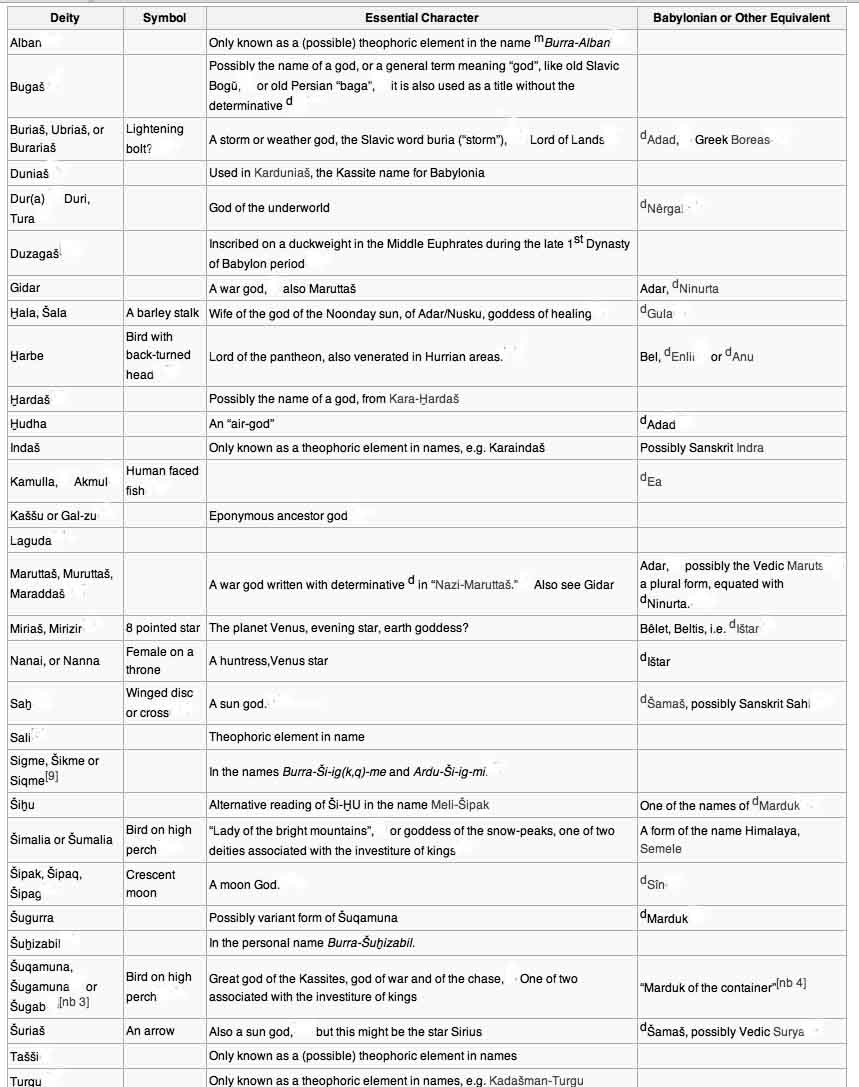
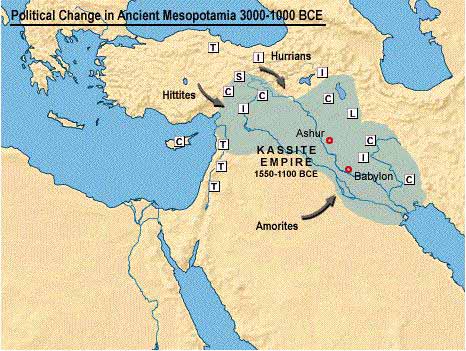


The Kassites were an ancient Near Eastern people who gained control of Babylonia after the fall of the Old Babylonian Empire after ca. 1531 BC to ca. 1155 BC (short chronology). Their Kassite language is thought to have been related to Hurrian, and not Indo-European or Semitic although the evidence for its genetic affiliation is meager due to the scarcity of extant texts.
The original homeland of the Kassites is not well known, but appears to have been located in the Zagros Mountains in Lorestan in what is now modern Iran, although, like the Elamites, Gutians and Manneans, they were unrelated to the later Indo-European/Iranic Medes and Persians who came to dominate the region a thousand years later.
They first appeared in the annals of history in the 18th century BC when they attacked Babylonia in the 9th year of the reign of Samsu-iluna (reigned ca. 1749–1712 BC), the son of Hammurabi. Samsu-iluna repelled them, as did Abi-Eshuh, but they subsequently gained control of Babylonia circa 1570 BC some 25 years after the fall of Babylon to the Hittites in ca. 1595 BC, and went on to conquer the southern part of Mesopotamia, roughly corresponding to ancient Sumer and known as the Dynasty of the Sealand by ca. 1460 BC.
The Hittites had carried off the idol of the god Marduk, but the Kassite rulers regained possession, returned Marduk to Babylon, and made him the equal of the Kassite Shuqamuna. The circumstances of their rise to power are unknown, due to a lack of documentation from this so-called "Dark Age" period of widespread dislocation. No inscription or document in the Kassite language has been preserved, an absence that cannot be purely accidental, suggesting a severe regression of literacy in official circles. Babylon under Kassite rulers, who renamed the city Karanduniash, re-emerged as a political and military power in Mesopotamia. A newly built capital city Dur-Kurigalzu was named in honour of Kurigalzu I (ca. early 14th century BC).
Their success was built upon the relative political stability that the Kassite monarchs achieved. They ruled Babylonia practically without interruption for almost four hundred years— the longest rule by any dynasty in Babylonian history.
The transformation of southern Mesopotamia into a territorial state, rather than a network of allied or combatative city states, made Babylonia an international power, although it was often overshadowed by its northern neighbour, Assyria and by Elam to the east. Kassite kings established trade and diplomacy with Assyria. (Puzur-Ashur III of Assyria and Burna-Buriash I signed a treaty agreeing the border between the two states in the mid 16th Century BC), Egypt, Elam, and the Hittites, and the Kassite royal house intermarried with their royal families. There were foreign merchants in Babylon and other cities, and Babylonian merchants were active from Egypt (a major source of Nubian gold) to Assyria and Anatolia. Kassite weights and seals, the packet-identifying and measuring tools of commerce, have been found in as far afield as Thebes in Greece, in southern Armenia, and even in a shipwreck off the southern coast of today's Turkey.
A further treaty between Kurigalzu I and Ashur-bel-nisheshu of Assyria was agreed in the mid 15th century. However, Babylonia found itself under attack and domination from Assyria for much of the next few centuries after the accession of Ashur-uballit I in 1365 BC who made Assyria (along with the Hittites and Egyptians) the major power in the Near East.
Babylon was sacked by the Assyrian king Ashur-uballit I (1365 BC - 1330 BC)) in the 1360s after the Kassite king in Babylon who was married to the daughter of Ashur-uballit was murdered. Ashur-uballit promptly marched into Babylonia and avenged his son-in-law, deposing the king and installing Kurigalzu II of the royal Kassite line as king there. His successor Enlil-nirari (1330 BC - 1319) also attacked Babylonia and his great grandson Adad-nirari I (1307 - 1275 BC) annexed Bablonian territory when he became king. Tukulti-Ninurta I (1244 BC - 1208 BC) not content with merely dominating Babylonia went further, conquering Babylonia, deposing Kashtiliash IV and ruling there for 8 years in person from 1235 BC to 1227 BC.
The Kassite kings maintained control of their realm through a network of provinces administered by governors. Almost equal with the royal cities of Babylon and Dur-Kurigalzu, the revived city of Nippur was the most important provincial center. Nippur, the formerly great city, which had been virtually abandoned ca. 1730 BC, was rebuilt in the Kassite period, with temples meticulously re-built on their old foundations. In fact, under the Kassite government, the governor of Nippur, who took the Sumerian-derived title of Guennakku, ruled as a sort of secondary and lesser king. The prestige of Nippur was enough for a series of 13th century BC Kassite kings to reassume the title 'governor of Nippur' for themselves.
Other important centers during the Kassite period were Larsa, Sippar and Susa. After the Kassite dynasty was overthrown in 1155 BC, the system of provincial administration continued and the country remained united under the succeeding rule, the Second Dynasty of Isin.
Documentation of the Kassite period depends heavily on the scattered and disarticulated tablets from Nippur, where thousands of tablets and fragments have been excavated. They include administrative and legal texts, letters, seal inscriptions, kudurrus (land grants and administrative regulations), private votive inscriptions, and even a literary text (usually identified as a fragment of a historical epic).
"Kassite rulers in Babylon were also scrupulous to follow existing forms of expression, and the public and private patterns of behavior "and even went beyond that - as zealous neophytes do, or outsiders, who take up a superior civilization - by favoring an extremely conservative attitude, at least in palace circles." (Oppenheim 1964, p. 62). Over the centuries, however, the Kassites were absorbed into the Babylonian population. Eight among the last kings of the Kassite dynasty have Akkadian names, Kudur-Enlil's name is part Elamite and part Sumerian and Kassite princesses married into the royal family of Assyria.
The Book of Judges in the Hebrew Bible contains a reference to what appears to be a Kassite ruler, who is named as Cushan-Rishathaim and described as ruler of "Aram Naharaim". "Cushan" is interpreted by Biblical scholars to mean "Kassite" and "Aram Naharaim" to mean northwest Mesopotamia. According to Judges, Cushan-Rishathaim conquered Israel shortly after the death of Joshua and held it for eight years.
The Elamites conquered Babylonia in the 12th century BC, thus ending the Kassite state. The last Kassite king, Enlil-nadin-ahi, was taken to Susa and imprisoned there, where he also died.
The Kassites did briefly regain control over Babylonia with Dynasty V (1025 BC-1004 BC), however they were deposed once more, this time by an Aramean dynasty.
Kassites survived as a distinct ethnic group in the mountains of Lorestan (Luristan) long after the Kassite state collapsed. Babylonian records describe how the Assyrian king Sennacherib on his eastern campaign of 702 BC subdued the Kassites in a battle near Hulwan, Iran.
Herodotus and other ancient Greek writers sometimes referred to the region around Susa as "Cissia", a variant of the Kassite name. However, it is not clear if Kassites were actually living in that region so late.
Herodotus was almost certainly referring to Kassites when he described "Asiatic Ethiopians" in the Persian army that invaded Greece in 492 BC. Herodotus was presumably repeating an account that had originally used the name "Cush", or something similar, to describe the Kassites; "Cush" was also a name for Ethiopia. A similar confusion of Kassites with Ethiopians is evident in various ancient Greek accounts of the Trojan war hero Memnon, who was sometimes described as a "Cissian" and founder of Susa, and other times as Ethiopian. According to Herodotus, the "Asiatic Ethiopians" lived not in Cissia, but to the north, bordering on "Paricanians" who in turn bordered on the Medes.
During the later Achaemenid period, the Kassites, referred to as "Kossaei", lived in the mountains to the east of Media and were one of several "predatory" mountain tribes that regularly extracted "gifts" from the Achaemenid Persians, according to a citation of Nearchus by Strabo (13.3.6).
But Kassites again fought on the Persian side in the Battle of Gaugamela in 331 BC, in which the Persian Empire fell to Alexander the Great, according to Diodorus Siculus (17.59) (who called them "Kossaei") and Curtius Rufus (4.12) (who called them "inhabitants of the Cossaean mountains"). According to Strabo's citation of Nearchus, Alexander later separately attacked the Kassites "in the winter", after which they stopped their tribute-seeking raids.
Strabo also wrote that the "Kossaei" contributed 13,000 archers to the army of Elymais in a war against Susa and Babylon. This statement is hard to understand, as Babylon had lost importance under Seleucid rule by the time Elymais emerged around 160 BC. If "Babylon" is understood to mean the Seleucids, then this battle would have occurred sometime between the emergence of Elymais and Strabo's death around 25 AD. If "Elymais" is understood to mean Elam, then the battle probably occurred in the 6th century BC. Note that Susa was the capital of Elam and later of Elymais, so Strabo's statement implies that the Kassites intervened to support a particular group within Elam or Elymais against their own capital, which at that moment was apparently allied with or subject to Babylon or the Seleucids.
The latest evidence of Kassite culture is a reference by the 2nd century geographer Ptolemy, who described "Kossaei" as living in the Susa region, adjacent to the "Elymeans". This could represent one of many cases where Ptolemy relied on out-of-date sources.
It is believed that the name of the Kassites is preserved in the name of the Kashgan River, in Lorestan.
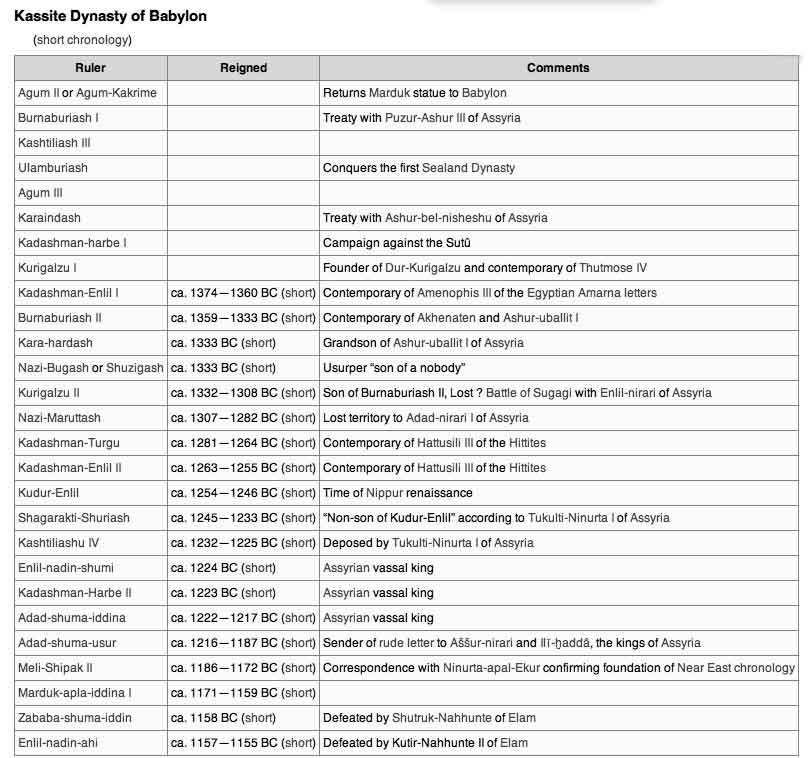
Kassite (Cassite) was a language spoken by Kassites in northern Mesopotamia from approximately the 18th to the 4th century BC. From the 16th to 12th centuries BC, kings of Kassite origin ruled in Babylon until they were overthrown by Elamites.
Kassites in the Babylon state used mostly the Akkadian language. Traces of the Kassite language are few: a short Kassite-Akkadian dictionary containing agricultural and technical terms, names of colors etc., and lists of personal names (some names are collated with Semitic equivalents), names of deities and horses. A lack of Kassite texts makes the reconstruction of Kassite grammar impossible at present.
Genetic relations of the Kassite language are unclear, although it's believed to be unrelated to Semitic; relation with Elamite is doubtful. Some words may have been adopted from the Indo-Iranian languages. The Kassite language was possibly related to Hurro-Urartian.
Morphemes are not known; the words buri (ruler) and burna (protected) probably have the same root.
n spite of the fact that some of them took Babylonian names, the Kassites retained their traditional clan and tribal structure, in contrast to the smaller family unit of the Babylonians. They were proud of their affiliation with their tribal houses, rather than their own fathers, and preserved their customs of fratriarchal property ownership and inheritance.
The most notable Kassite artifacts are their Kudurru steles. Used for marking boundaries and making proclamations, they were also carved with a high degree of artistic skill.
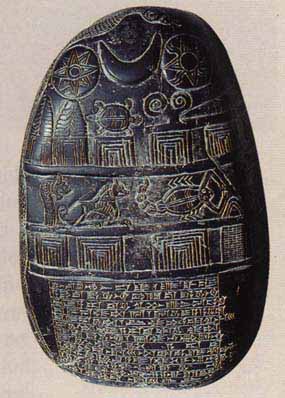
Astronomy
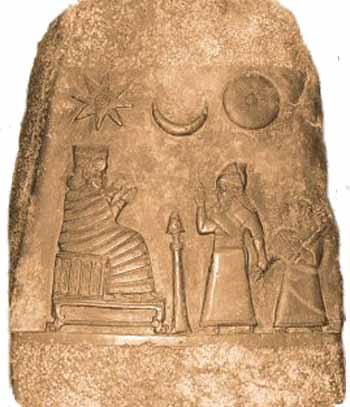
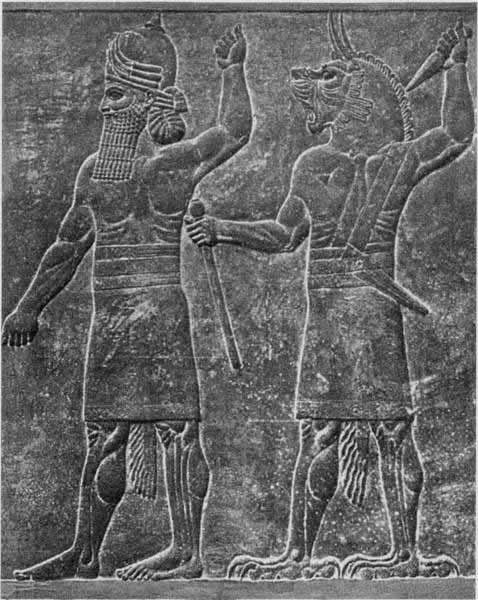
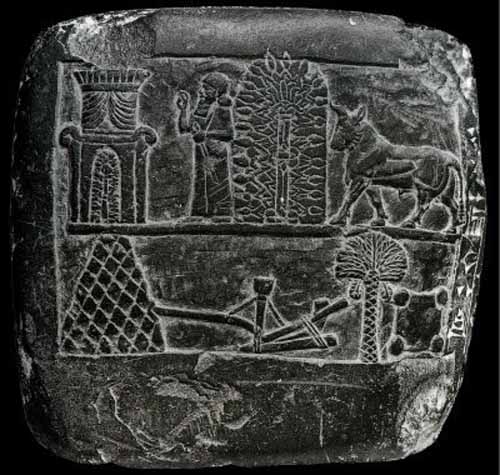
Tree of Life
The Kassites, the ancient Near Eastern people who seized power in Babylonia following the fall of the first Babylonian Dynasty and subsequently went on to rule it for some three hundred and fifty years during the late bronze age, possessed a pantheon of gods but few are known beyond the laconic mention in the theophoric element of a name. The only Kassite deities who had separate and distinct temples anywhere in Babylonia were apparently the patron deities of the royal family, Suqamuna and Sumaliya.
The evidence from the Kassite-Akkadian vocablary (pictured) discovered by Hormuzd Rassam and the Kassite-Akkadian name list is that the Kassites identified their gods with those of Mesopotamia, if these sources are sufficiently contemporary. Mountain gods were a popular motif in Kassite art, on cylinder seals and, for example, the brickwork faćade of the temple of Karaindas, he "Eanna of Inanna." The generic term for “god” in the Kassite language was mashu or bash
Of the three hundred or so known Kassite words, around thirty of them are thought to be the names of deities, some strikingly similar to Indo-European god-names and this has been conjectured to be through contact transmission rather than linguistic affiliation. The language itself has been compared to several, such as Hittite and Elamite but genetically found wanting, possibly with the exception of the Hurrian language.
The evidence available for assembling a list of the pantheon of Kassite gods is meager. Perhaps three bilingual lists exist which provide Akkadian equivalents to Kassite gods, translations of names which include Kassite theophoric elements, or a handful of Kassite words, including god-names, with their Assyrian counterparts but some of these identifications must be considered tentative due to the circumstantial evidence that the elements actually represent deities, rather than, for example, some topographical feature. Kassites
